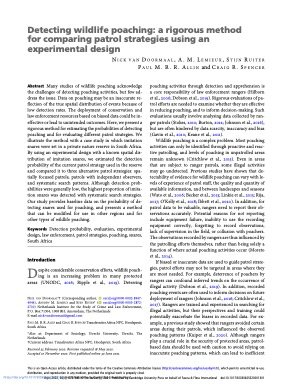By The United Nations Office on Drugs and Crime (UNODC)
Three Key Questions ♦ How are the activities of law enforcement agencies impacted by climate change and what are the implications of this for future practice? ♦ What capacities and organisational attributes are required by law enforcement agencies in responding to the challenges posed by climate change and environmental degradation? ♦ What improvements can be made to law enforcement responses to the challenges posed by climate change and environmental degradation? Legal and Professional Contexts ♦ Crimes that affect the environment are increasingly being prioritised by the United Nations and other international bodies, as well as regional and domestic authorities. ♦ A paradigm shift is occurring due to changing circumstances that is reshaping contemporary responses to the law enforcement mission and mandate. This has ramifications for how law enforcement work is carried out, the resources needed to do so, and the collaborations required across agencies and between community and government. Crimes that Affect the Environment and Climate Change ♦ Crimes that Affect the Environment Contributing to Climate Change Deforestation – diminishment of carbon sinks, adding to carbon emissions; Illegal mining – air pollution; polluting freshwater systems, Wildlife trafficking – loss of certain species and individuals may undermine the functioning of ecosystems exacerbating conditions leading to climate change; Land grabs and changing land uses – lost carbon stock and sequestration, adding to carbon emissions. ♦ Climate Change Affecting Existing Categories of Crime Water crimes – resource scarcity and water theft; Clandestine migration – climate refugees; Illegal mining – rare earth minerals for new renewable energy systems; Social conflict – aggression and violence over scarce resources, social strains arising from biophysical changes, changes in routine activities depending on weather. ♦ Cross-Over Crimes Associated with Crimes that Affect the Environment and Climate Change Homicide – killing of park rangers, environmental activists, local residents; Organised crime groups and networks – fraudulent green investments, low-price food on-sales; Corruption – direct (criminal such as document fraud) and moral (unethical policies and practices that foster carbon emission pollution); Disaster-related fraud – building practices, insurance claims, victim scams and identity theft. Climate Change Risks and Disasters ♦ The planet is heating up at an unprecedented rate and this is accelerating. The effects of this are manifest in high impact and extreme weather events and increases in all manner of risks and harms. This is global in nature. ♦ The notion of harmscape captures the idea of intersecting and interacting harms. Climate change impacts and risks are becoming increasingly complex and more difficult to manage. ♦ The intersectional dimensions of responding to climate disruption include three main features: climate related crimes (e.g., water theft); climate-related events (e.g., wildfires); and climate-related problems (e.g., prolonged homelessness), all of which are interconnected. Capacities and Capabilities of Law Enforcement Agencies ♦ While there may be rising interest and need for greater law enforcement intervention arising from climate-related events and trends, at present there is generally insufficient capacity to meet the challenges of either crime fighting or disaster and emergency management. ♦ A change in and pluralisation of police roles is occurring, in which greater attention is being devoted to matters such as climate change mitigation, reduction of climate-related crime or first responder work on the frontline of environmental disasters. ♦ There are a multitude of stakeholders and agencies with which law enforcement must engage and collaborate with, with numerous tensions and opportunities evident at the grassroots level with regard to state-community relations. A New Paradigm for Global Law Enforcement ♦ A robust response to climate-related crime and disaster events hinges to a large extent on the strength and resilience provided by the community and NGO sectors working in conjunction with state authorities. ♦ A wide range of equipment and technologies are required in the fight against climate-related crimes and in responding to disasters and emergencies. These need to be shared out at the global scale. ♦ Information management systems are crucial to both combating climate-related crimes as well as predicting and responding to climate-related disasters and their short- and long-term social and environmental consequences. ♦ It is vital that multi-agency and multi-disciplinary teams and forums be provided that bring together in a coordinated manner the knowledge, expertise and experience of a wide range of practitioners. ♦ A range of strategic actions are required for effective environment and climate-related global law enforcement. The emphasis must be on preparedness and rapid mobilisation of human and technical resources.
Vienna: UNODC, 2024. 70p.








